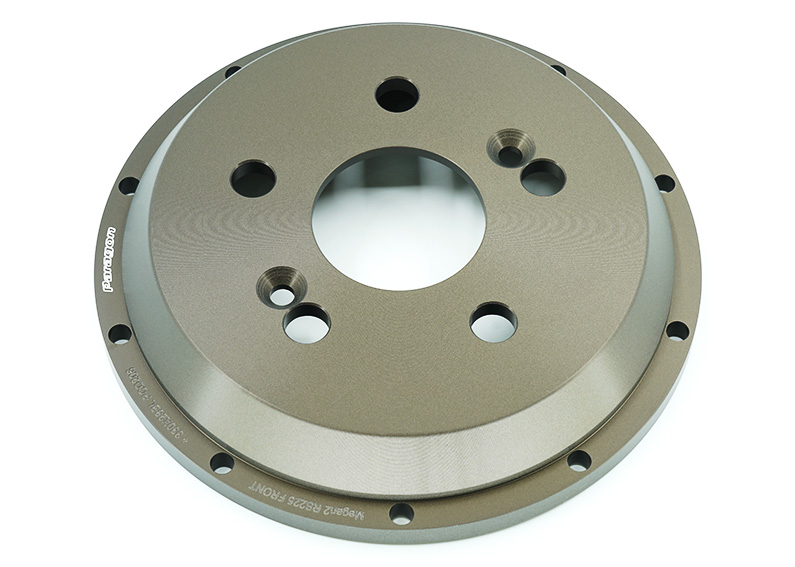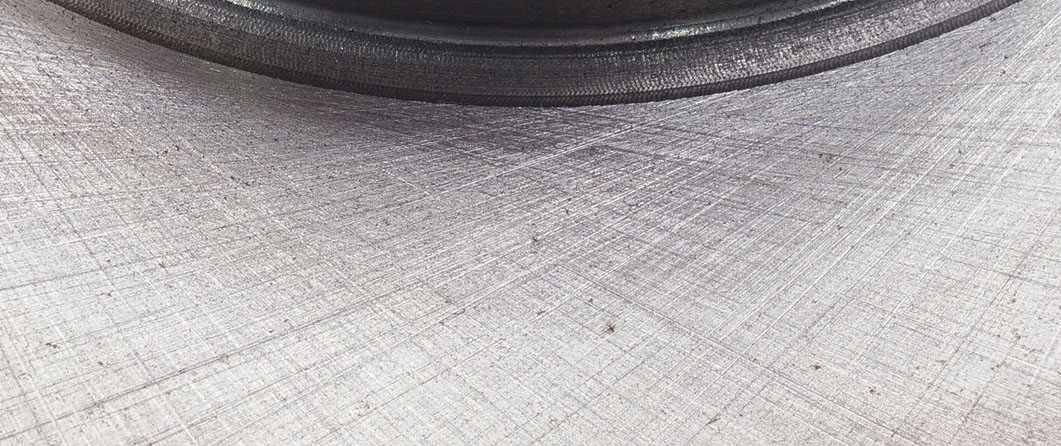Pad depth / D / Annulus / Radial Depth:
The area between the outer and inner diameter of the rotor or brake pad. Higher number means more friction surface areas.
Rotor pad depth: Area between Internal Diameter "ØC", and Inside Flange Diameter "ØD". Also referred as "maximum pad depth".
Brake pad pad depth:

In most cases, our rotors are labelled with the most commonly used brake pad pad depth of that particular rotor.
Maximum pad depth:
The maximum pad depth that a particular rotor can accommodate.
(Internal Diameter "ØC" minus Inside Flange Diameter "ØD") ÷ 2 = maximum pad depth.
In most cases, the pad depth (D) of the brake pads will be lower than the pad depth of the rotors. Higher number means more possible friction surface areas.

Air vane gap:
The area between the ventilation vanes. More area means more airflow and is critical to the cooling capacity of the rotors.
Type of flange face:
On Paragon Performance rotors, there are 3 types of flange faces: step up, flat, and step down. Most Paragon Performance rotors utilize the step up flange face design.
Directional ventilation vanes:
Ventilation vanes that are designed to function in a particular direction. All Paragon Performance rotors feature directional ventilation vanes to create suction, turbulence, and guides cool air through the rotor to achieve greater thermal capacity and increased resistance to cracking under harsh track condition. Each rotor is left or right side specific and the ventilation vanes are optimized to spin in a particular direction to pump the maximum amount of cool air through the rotor. Compared to standard rotors with pillar vanes, rotors with directional ventilation vanes can run up to 30% cooler.

Floating:
Floating is an effective solution to rotor radial heat expansion. Sport driving place great strains on the brake system, and generate tremendous amount of heat. As temperature increases, iron rotor rings tend to expand and increase in diameter (thermal expansion). With the use of floating hat & hardware, the floating 2-piece design allows expansion of the rotor assembly, and minimizes stress, deformation and cracking. Fully-floating design (as seen on rotors with H-Bobbin, T-Bobbin, or S-Bobbin mounting systems) will allow "float" in both radial and axial directions according to temperature change for best braking performance. The rotor is self-centered with the pads throughout the heat cycle and therefore allows consistent braking power and pedal feel.
2-piece rotors:
2-piece rotors consist of 2 separate pieces: aluminum hats and rotor ring (friction ring). Aluminum hats are made of lightweight aerospace grade aluminum for weight reduction, and rotor rings are made of special formulated high carbon alloy iron for optimum thermal properties and braking performance. Advantages of 2-piece design are reduced chance of warping or cracking, lower replacement cost, weight reduction, longer rotor life and able to utilize a floating design, etc. The aluminum hat is fastened onto the rotor ring with either floating or non-floating rotor attachment hardware depending on applications.
Aluminum hat:

Rotor Rings:

Thermal capacity:
Thermal capacity of a rotor refers to the ability of the rotor to absorb and dissipate heat without reaching temperatures that would affect its performance. Apart from the material’s thermal properties, one determining factor would be the mass of the rotor ring (friction ring). The more mass in the rotor ring, the more thermal capacity a rotor has. Thermal capacity is critical to the performance and longevity of a rotor especially in track / race applications. Rotors with inadequate heat capacity will easily result in thermal cracking, deformation, vibration, and brake fade, etc.
Heat treating:
Heat treating refers to the process that uses controlled heat to release residual stress in the rotor to avoid wrapping and brake judder. Residual stress exists in all cast iron rotors. During casting, hot liquid metal is poured into the mold, then cools and turns into solid state. This process creates stress inside the casting. If the casting (rotor) is exposed to high temperature again, stress inside the casting will be released and therefore change the shape of the casting. For street applications, heat treating is not necessary as regular street vehicles are rarely exposed to high temperature. However, in the case of high performance rotors, releasing residual stress becomes necessary as prolonged, repeated heat cycles from high to low temperatures lead to extra contraction and expansion of the material. With heat treating, rotors are heated to release residual stress and deform before it is precisely machined. This can ensure that the rotor will not deform during actual use due to residual stress, and all machining works are being processed after the initial deform of the rotor. All Paragon Performance rotors are heat treated using convection heat treating oven for optimal results.
CBN surface machining:
CBN (Cubic Boron Nitride) is the second hardest material after diamond. CBN tools provide excellent cutting and turning performance which ensure better break-in with new brake pads by allowing an even brake pad transfer layer deposition and an even contact surface.
Paragon rotor with CBN surface finish:

Rotor with ground surface finish (commonly seen on regular 1-piece rotors for reduced production cost):

Mil-spec hard anodizing:
Mil-spec hard anodizing (MIL-A-8625 Type III) will not discolor under extreme heat, and is harder, thicker, and more wear and scratch resistant. Hard anodized surface will last longer than black anodized surface, and is highly recommended for track / race applications. Hard anodizing allows for a thicker hard coat which provides advanced corrosion resistance and low-maintenance durability. Hard anodized surface will hold up better when exposed to ultraviolet (UV) light, and is even more important if the vehicle is exposed under outdoor conditions frequently.

Lateral run-out:
Rotor lateral runout is the side to side movement of the rotor as it rotates. Excessive rotor lateral run-out will lead to vibration and pulsation. All Paragon Performance rotors are inspected to keep the run-out below 0.03mm.

CM-250 Special Alloy Iron:
CM-250 is a special formulated high carbon alloy cast iron material exclusively available for Paragon Performance rotors. High carbon content allows the rotor to take a lot of heat and dissipate it quickly. Copper and exotic metals including molybdenum are added for improved strength, resistance to cracking, and thermal characteristics. After years of development and track testing, this material has been proven to perform under extreme track conditions. It allows for an optimized bite, longevity, high-temperature strength and heat-cycle durability.







